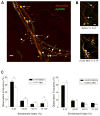Neurexin-neuroligin transsynaptic interaction mediates learning-related synaptic remodeling and long-term facilitation in aplysia
- PMID: 21555073
- PMCID: PMC3136118
- DOI: 10.1016/j.neuron.2011.03.020
Neurexin-neuroligin transsynaptic interaction mediates learning-related synaptic remodeling and long-term facilitation in aplysia
Abstract
Neurexin and neuroligin, which undergo heterophilic interactions with each other at the synapse, are mutated in some patients with autism spectrum disorder, a set of disorders characterized by deficits in social and emotional learning. We have explored the role of neurexin and neuroligin at sensory-to-motor neuron synapses of the gill-withdrawal reflex in Aplysia, which undergoes sensitization, a simple form of learned fear. We find that depleting neurexin in the presynaptic sensory neuron or neuroligin in the postsynaptic motor neuron abolishes both long-term facilitation and the associated presynaptic growth induced by repeated pulses of serotonin. Moreover, introduction into the motor neuron of the R451C mutation of neuroligin-3 linked to autism spectrum disorder blocks both intermediate-term and long-term facilitation. Our results suggest that activity-dependent regulation of the neurexin-neuroligin interaction may govern transsynaptic signaling required for the storage of long-term memory, including emotional memory that may be impaired in autism spectrum disorder.
Copyright © 2011 Elsevier Inc. All rights reserved.
Figures








Comment in
-
Transsynaptic coordination of presynaptic and postsynaptic modifications underlying enduring synaptic plasticity.Neuron. 2011 May 12;70(3):379-81. doi: 10.1016/j.neuron.2011.04.016. Neuron. 2011. PMID: 21555066 Free PMC article.
References
-
- Bailey CH, Chen M. Morphological basis of long-term habituation and sensitization in Aplysia. Science. 1983;220:91–93. - PubMed
-
- Bailey CH, Montarolo PG, Chen M, Kandel ER, Schacher S. Inhibitors of protein and RNA synthesis block the structural changes that accompany long-term heterosynaptic plasticity in the sensory neurons of Aplysia. Neuron. 1992;9:749–758. - PubMed
-
- Bailey CH, Kandel ER, Si K. The persistence of long-term memory: a molecular approach to self-sustaining changes in learning-induced synaptic growth. Neuron. 2004;44:49–57. - PubMed
-
- Bailey CH, Kandel ER. Synaptic remodeling, synaptic growth and the storage of long-term memory in Aplysia. In: Sossin W, Lacaille J-C, Castellucci VF, Belleville S, editors. The Essence of Memory Progress in Brain Research. Vol. 169. Elsevier Press; 2008. pp. 179–198. - PubMed
Publication types
MeSH terms
Substances
Associated data
- Actions
- Actions
Grants and funding
LinkOut - more resources
Full Text Sources

